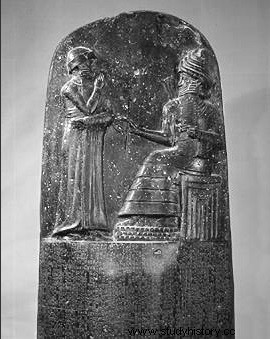 Discovered around 1901 in Mesopotamia by Jacques de Morgan, the Code of Hammurabi is the oldest legal corpus known in its entirety. This block of black diorite more than two meters high represents on its upper part, Shamash, the sun god, presenting to Hammurabi a ring symbolizing the legislative power. Below is engraved a long collection of royal sentences considered exemplary. The "Code of Hammurabi" stele is today one of the prides of the Department of Oriental Antiquities at the Louvre Museum
Discovered around 1901 in Mesopotamia by Jacques de Morgan, the Code of Hammurabi is the oldest legal corpus known in its entirety. This block of black diorite more than two meters high represents on its upper part, Shamash, the sun god, presenting to Hammurabi a ring symbolizing the legislative power. Below is engraved a long collection of royal sentences considered exemplary. The "Code of Hammurabi" stele is today one of the prides of the Department of Oriental Antiquities at the Louvre Museum
Hammurabi, a wise monarch
Hammurabi (or Hammurabi) was a Babylonian ruler who ruled in the 18th century BCE. Having unified his conquests under a central government in Babylon, Hammurabi devoted his forces to protecting his borders and fostering the internal prosperity of his empire. During his long reign, he supervised navigation, irrigation, agriculture, tax collection and the construction of many temples and various buildings.
A successful military leader and administrator, Hammurabi was also the instigator of a collection of laws governing life in Babylon. This text, known as the Code of Hammurabi, exerted a considerable influence on the ancient East.
The Code of Hammurabi
At the initiative of King Hammurabi of Babylon, a monument was made of black basalt around 1750 BC. Placed in the temple of Sippar, a city located north of Babylon, it was then moved to Iran in the 1200s BC. AD and Jacques de Morgan discovered it in Susa in December 1901, broken into three pieces. This two-metre-twenty-five-high stele was reconstructed without leaving significant traces of damage.
 It represents in its upper part a bas-relief representing the king and the sun god Shamash, seated on his throne. Able to see everything, Shamash is associated with justice and dictates laws to rulers. He is depicted here giving the king a ring symbolizing legislative power. On the lower part is engraved a long text written in cuneiform characters and in the Akkadian language.
It represents in its upper part a bas-relief representing the king and the sun god Shamash, seated on his throne. Able to see everything, Shamash is associated with justice and dictates laws to rulers. He is depicted here giving the king a ring symbolizing legislative power. On the lower part is engraved a long text written in cuneiform characters and in the Akkadian language.
Of Mesopotamian origin, the stele was engraved with two hundred and eighty-two articles, in the form of a code, with the aim of homogenizing the kingdom. These cuneiform scriptures in the Akkadian language are grouped into three parts:
- a history of the life and role of the king with his precept "to ensure that the strong do not oppress the weak",
- then a series of laws written in simple language so that all its people understand, concerning justice, wisdom, the rules of everyday family life – status of the women, rules of marriage, divorce, adultery, incest, children, inheritance - economic functioning such as the cost of medical services or management in the agricultural field because the king attached great importance to the maintenance of the canals used for transport of goods, salaries of different categories of people, professional responsibilities, rules of religious life. For the penalties incurred for thefts, misdemeanors and various crimes (the law of retaliation), the texts are written in a dissuasive manner "if an individual has done such an action, such a thing will happen to him"!
- finally an epilogue summarizing the work of the king in terms of justice, as well as the balance sheet of his prestigious reign. The king was also called "king of the four regions", an imperial title meaning king of the universe, and one of the most prestigious of ancient Mesopotamia.
This code is not a simple list of laws and rules to be respected, it is intended to be an ideal model of wisdom and fairness for future generations. Indeed, the schools of scribes used it for more than a thousand years.
Bibliography
- The Code of Hammurabi, by Béatrice André-Salvini. Editions Somogy, 2016.
- History of Mesopotamia, by Véronique Grandpierre. Folio History, 2010.
